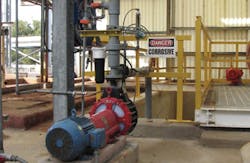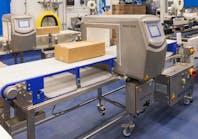One of the site’s three main processing units manufactures MBS, a methacrylate butadiene styrene copolymer. This white powder is an impact strength modifier for PVC. For applications such as clear PVC plastic bottles, adding around 10% MBS increases the impact resistance of the PVC without decreasing transparency.
Like most fine chemical operations, the MBS plant needs a plentiful supply of demineralized water, explains Paul Franks, an industry veteran who works with the site on a contract basis.
The plant’s utility area includes several water demineralization units. The largest, installed in 1997, uses ion-exchange technology to remove dissolved substances from incoming raw water. To maintain performance, the ion-exchange beds are regenerated periodically using strong acids and alkalis. Regeneration yields an acidic effluent from the cation resin bed and an alkaline effluent from the anion bed.
Both streams discharge into a lined sump measuring 25 feet by 13 feet by 8 feet deep. A sump agitator combines the acidic and alkaline streams to create a mixture whose pH is close to neutral. Mixed effluent is pumped to the site’s common wastewater pit, from where it is transferred by pipeline to a public waste treatment plant three miles away.
Polypropylene pump prevents corrosion
The pump originally installed to empty the agitated sump was prone to corrosion despite being made from stainless steel. Because it proved unreliable and was not self-priming, standard practice was to circumvent it.
Instead, operators allowed liquid effluent to overflow from the agitated sump into a backup sump installed when another demineralization unit was added to meet plant capacity expansion. The backup sump is equipped with a Vanton SG PY1200 thermoplastic vertical sump pump whose corrosion-resistant, chemically inert thermoplastic is impervious to aggressive pumped fluids. The pump has performed reliably since being installed, becoming the usual means of transferring effluent from the agitated sump to the plant’s common wastewater pit.
Since the stainless steel pump in the agitated sump was inactive, however, failure of the thermoplastic pump in the backup sump would require plant operators to use a portable air-operated diaphragm pump to empty both sumps — a time-consuming and potentially hazardous business. If wastewater wasn’t pumped out quickly enough, a shortage of demineralized water would limit plant production. Kaneka, therefore, sought an alternative to the stainless steel pump in the agitated sump.
Corrosion resistance was a priority, because the individual effluent streams are strongly acidic and alkaline — and highly corrosive until achieving near-neutral pH when fully mixed in the correct proportion. If acidic or alkaline stream volumes vary, however, the resulting mixture attacks metals, evidenced by pump corrosion, as well as corrosion of the steel walkway supporting the pump and FRP agitator.
Kaneka knew it wanted a thermoplastic pump for corrosion resistance. It considered using plastic-lined steel pumps, but based on previous experience in the end opted for all-plastic pumps. A vertical sump pump would have required structural steelwork, so a self-priming, horizontal pump was specified.
The Vanton Prime-Gard PY450 self-priming horizontal centrifugal pump chosen has 2-inch nozzles and is rated for flows of 120 gpm against 90 foot head. All wetted components of the pump are injection molded of chemically inert polypropylene, eliminating fluid to metal contact.
With a suction lift of around 8 feet there were some initial concerns about the pump’s net positive suction head (NPSH) requirement, but working with the local Vanton representative it was confirmed the horizontal pump would do the job.
Against dirt and dry running
Waste streams from the demineralizer also contain dirt and organic compounds taken from the raw water by the ion exchange beds, as well as particles of ion exchange resin. "It’s not the cleanest fluid, and there is a persistent foam residue on the walls of the pit," says Franks.
To shield it from suspended particles, the pump’s single mechanical seal has a simple, once-through water flush via a 10-micron single-element cartridge filter. "We might have gotten away without a seal flush, but I believe in protecting seals," Franks says.
The primary protection against a pump’s dry running is a low-level shutdown switch on the sump. In the unlikely event of switch failure, secondary protection is afforded by a 3 gpm flow of clean water to the pump suction, protecting the pump case, seals and bearings from overheating.
The polypropylene pump has run reliably for more than two years, Franks says. "After its initial priming, the pump has not lost prime, and it empties the pit in approximately two and a half hours." Also important, should the agitator ever break down, the pump would have no trouble handling the unmixed acidic and alkaline effluent streams.
Acidic wastewater at CPVC unit
Another unit at the site makes CPVC (chlorinated polyvinyl chloride), widely used for fire-resistant piping, electrical fittings and other products requiring high temperature, impact and broad chemical resistance.
Maintenance engineer Peter Whitley explains that CPVC’s main ingredient is PVC powder, which is received by rail. The powder is suspended as slurry in water and chlorinated via a photochemical reaction. The resulting CPVC powder is then washed in a series of centrifuges, dried and packed. Any free chlorine left after the chlorination reaction ends up as hydrochloric acid in the wash water, so wastewater treatment must be addressed carefully and corrosion is a potential problem.
Under normal operating conditions wastewater pH from the CPVC plant is close to neutral. Previously, wastewater collected in a sump from where it flowed by gravity to the site’s common wastewater pit, before being pumped to the municipal treatment plant.
But occasionally a process upset occurred, and wastewater from the CPVC plant became acidic to the point where direct discharge to the offsite treatment plant would have violated the plant’s discharge consent. Kaneka therefore decided to install a second sump, approximately 4 by 6 by 8 feet deep, in which any acidic wastewater is neutralized by adding powdered limestone. This is now the standard method of operation.
To transfer the wastewater from the first to the second sump, Kaneka installed a Vanton thermoplastic SGK PY1200 vertical cantilevered sump pump. Whitley says, "We chose this pump based on good experience with Vanton pumps elsewhere on the site."
The pump has 3-inch by 2-inch nozzles and is rated at 340 gpm against a total dynamic head of 85 feet. All fluid contact parts are of solid, inert polypropylene. The large-diameter, stainless steel, cantilevered shaft, which is sleeved in thick-sectioned polypropylene, eliminates the need for a submerged bearing, allowing the pump to run dry for indefinite periods with no damage.
In normal operation the pump starts frequently and runs for a few minutes at a time, controlled by low- and high-level float switches. The pump has operated for years in this manner, and according to Whitley, without incident.
Pump circulates hydrochloric acid
Following the washing process discussed above, CPVC powder is dried using heated air, which picks up acid vapors. Before this air can be discharged to the environment, acid is removed by a Venturi scrubber and a 20-inch diameter packed tower.
For both devices, the scrubbing liquid — a 1.5% hydrochloric acid solution — is circulated by another Vanton thermoplastic pump, this one a CGA KY 4×3-10 horizontal centrifugal pump.
All pump wetted components are injection molded of inert PVDF. The pump has 4-inch by 3-inch nozzles and runs at 1,800 rpm, providing a flow rate of 340 gpm against an 85 feet total dynamic head. Although corrosive, the fluid is fairly clean, requiring a single mechanical seal with an external water flush.
This pump dates from the original construction of the CPVC plant, in July 2008, and was supplied with CPVC and FRP pipework as a packaged unit. Since then it has run continuously, halted only when the plant shuts down for three days once a month, and has otherwise operated without interruption.



